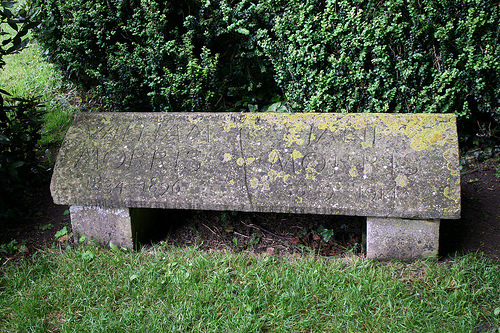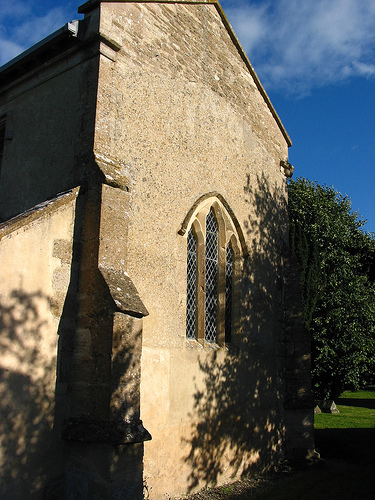| William Morris is buried in St George's churchyard
in Kelmscott,
Oxfordshire, England. His gravestone was designed by his
friend Philip Webb.
William
Morris (24 March 1834 – 3 October 1896) was a brilliant
designer, craftsman and political thinker, as well as
one of the most popular poets of his day. He was born in
Walthamstow and educated at Marlborough and Oxford.

William Morris' Grave
(Photo by
Martin Beek)

Kelmscott Church (Photo
by
Martin Beek)
At
Oxford he began to develop his interest in art and
architecture and met his life-long friend, Edward
Burne-Jones. Morris and Burne-Jones moved to London in
1856 and became part of the circle of the Pre-Raphaelite
painter and poet, Dante Gabriel
Rossetti. In 1857, Rossetti was commissioned to
supervise decorative work in the new Oxford Union
building. He enlisted his friends for this task, and
during this period Morris met his future wife, Jane
Burden. Morris and Jane married in 1859. Their initial
happiness did not last but they remained together until
Morris's death. When Jane became involved in a
relationship with Rossetti, he and Morris took on the
lease of a house at Kelmscott in Oxfordshire, providing
a refuge for Jane and the two children, and a place
where she and Rossetti could be together away from the
public gaze.
Morris
was a prolific writer of poetry, fiction and essays. He
published six volumes of poetry: The Defence of
Guenevere (1858); The Life and Death of Jason
(1867); The Earthly Paradise (1868-70); Love
is Enough (1873); Sigurd the Volsung (1876);
and Poems by the Way (1891). The Earthly
Paradise brought him almost immediate fame and
popularity.
In the
1870s Morris turned to Northern, particularly Icelandic,
sources to find renewed inspiration. He wrote less
original poetry but found time to translate the
Aeneid, the Odyssey and Beowulf. He
was approached with an offer of the Poet Laureateship
after the death of Tennyson
in 1892, but declined. His novel, The Wood Beyond the
World, is considered to have heavily influenced C.S.
Lewis' Narnia series. J.R.R. Tolkien was inspired by
Morris's reconstructions of early Germanic life in
The House of the Wolfings, and James Joyce also drew
inspiration from Morris's work.
When he
was dying one of his physicians diagnosed his disease as
'simply being William Morris and having done the work of
ten men'. In his obituaries he was remembered primarily
as a writer and was compared favourably
with Tennyson and
Browning. Morris was
generally reticent on the question of his religious
beliefs but there is abundant evidence that he thought
of himself as an atheist and regarded Christianity as a
beautiful mythology.
(Biographical details written by Angela Williams.)
|







